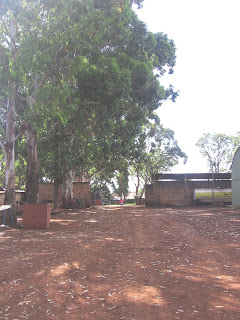 I've detailed below how & what I store on each shelf of my freezer to make the most of the space I have
I've detailed below how & what I store on each shelf of my freezer to make the most of the space I have
 I freeze as much as I can (even liquids like soup) in resealable plastic bags which I store flat like this - it saves so much space ! (This here is Bolognese Sauce for pasta - incase you were wondering !)
I freeze as much as I can (even liquids like soup) in resealable plastic bags which I store flat like this - it saves so much space ! (This here is Bolognese Sauce for pasta - incase you were wondering !)
Although I have quite a lot of freezer space I still have to conserve it as we live so far away from town/shops & it fills up so quickly with bulky things that take up a lot of space like loaves of bread & blocks of frozen pets meat. So, what I do to save as much space as I can, is to freeze everything that 'fits' in single or double portion sizes in resealable plastic bags which I then pack to lie flat (usually on top of one another - see the photo above) in the freezer.
For years I used solid square/round plastic contains with lids to freeze stuff in, until resealable plastic bags hit the shelves here, then I switched over and I haven't looked back since ! Don't be nervous to freeze liquids in resealable bags either - things like cheese sauce, Bolognese sauce and even soup freezes really well and saves you so much wasted space, and if you seal them properly and squeeze as much air out as possible, they won't leak at all ! I also store casseroles, frozen fruit (raspberries, mango, strawberries) and child sized portions of rice in smaller bags like this, which are quick to take out and pop into a bowl of hot water if I need to defrost them in a hurry.
The other photo above shows the bottom section of my main fridge in the kitchen, which contains my freezer drawers. I thought you might like to have a quick look so that I can show you how I organise it ....
On the top (narrow) shelf I store small packets of frozen fruit, rice and tortilla's/wraps.
The next shelf contains a few more bread items (frozen muffins, waffles etc) & pre cooked & portioned meals .... I have meatballs in the round plastic containers (I never freeze them flat in plastic bags as they do tend to get a bit squashed). I also have portions (in packets) of things like homemade hamburger patties, chicken curry, cottage pie filling (I freeze it in packets & then just tip it into a casserole dish & top with fresh mashed potato before grilling and serving as I don't like the texture of defrosted mashed potato !) and chopped up cooked chicken breasts (which are great for adding to salads, sandwiches or a sauce for a quick and easy supper).
The shelf beneath this contains all my raw meats (so that they don't drip onto the cooked stuff) like whole beef fillets, t-bone steaks, pork chops, fish fillets and whole chicken - things that I like to cook 'fresh'. I also use this shelf to store cold luncheon meats, bacon and sausages. (Okay I cheated here - as you can see - & added some packets of cooked Bolognese Sauce on the right. I was tired last night after making the sauce & fitted it in to the closest space I could find so that it would just freeze quickly before the generator went off for the night and the freezers did, too !)
The bottom shelf (yellow packet) contains 1 kg packets of frozen pet's mince. I keep the individual packets in one big packet so that no blood drips out on to the floor of the freezer .... egggh ! I also take all my scraps like chicken skin, fat trimmed off steaks, oil drained off stuff like bacon etc and freeze these in small bags which are added to the food for the stray village dogs I feed each night.
I also practice the "first in, first out" stock rotation system (I know - you'd swear I was still running a hotel or catering for 300 guests !) where when I get fresh supplies in, they go to the back of the particular shelf they belong on (eg. cold meat section or cooked meals) and the old stuff comes to the front. I do the same thing in my pantry/store room, too as I've found this system has worked well for me when we were running remote safari camps and it works just as well in my own home now too !
Oh yes and one more thing (I am pedantic in everything I do, incase you haven't noticed by now - ha ha !) I keep a "Stock List" on the main fridge door with all my stock listed in sections like "Cooked Meals", "Raw Meats" & "Baked Items" so that I always know what's in there & never have to rummage around looking for things. This is also a great help as it means I never run out of stuff, as I can see at a glance what I have.
So, there you have it - hope I didn't bore you too much with my excitement over the extremely thought provoking subject of How To Pack Your Freezer Efficiently. (Maybe I really should get out more, eh ?!)
 I made this vanilla sugar with vanilla pods grown right here in Tanzania - I try to support local products whenever I can
I made this vanilla sugar with vanilla pods grown right here in Tanzania - I try to support local products whenever I can













